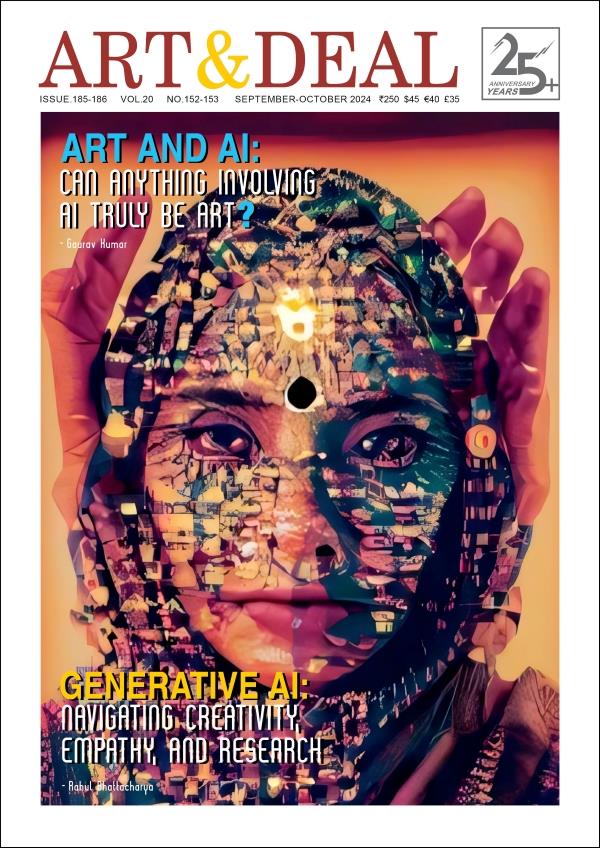Oscar Kokoschka, Guggenheim Bilbao Dieter Buchhart, Anna Karina Hofbauer Oberwildling by Rajesh Punj

1913, Oil on canvas, 80 x 120.1 cm, Leopold Museum, Vienne,
© Fondation Oskar Kokoschka, 2023, VEGAP, Madrid
Closing in on a hundred when he died in February 1980, Austrian artist Oscar Kokoschka’s oeuvre appears to pulsate with an increasing nervosity that riddled much of his life; as a teenager, moving from one makeshift home to another, to his youth, resisting his schooling for an underlying interest in art, and a yearning for a visual rudeness that was becoming prevalent across Europe at the turn of the century. The young Kokoschka saw a less sophisticated style as an unruly and radical antidote to the reaches of the establishment and industrialization, and he wasn’t alone in thinking that a mix of African, Oceania, and Native American art offered a more vigorous vocabulary for the arts. Likewise, (Paul) Gauguin in Tahiti, (Henri) Matisse and (Pablo) Picasso in Paris, and (Vincent) Van Gogh in Arles, all saw, what was considered ‘Primitivism’ as offering a coarser and more creative approach to picture making, as they all sought to rid representation of its realism. Likely aware of the ruptures his contemporaries were causing, Kokoschka came at the canvas with an equally expressive energy, that he explained as coming from ‘his whole being’; specifically, his 1937 self-portrait, Selbstbildnis eines “entarteten Künstlers” that was to embody everything of the ritual and risk of his life.
Racking over his life, Kokoschka appears not to have distinguished the private over the public, as Viennese society had rehearsed their entire lives. His mark-making, pencil, and paint, cover the surface as though he was undecided even in the moment. His relationships, especially with his lover of two years Alma Mahler, revealed a greater unease with everything, as his paintings appear like disillusioned dreams, in which awkward bodies with malign expressions fill much of the canvas; his scale and perspective are unclear. Kokoschka had decided, in works like Der Maler II (Maler und Modell II) 1923, Maler mit Puppe 1923, Marianne – Maquis – “Die zweite Front” 1947, and later with Theseus und Antiope (Raub der Antiope) 1958-73, and his final work Time, Gentleman, please 1971-72, to paint the day with night, the awake and dream-like, the living and the dead, simultaneously – the real and the emotional and imagined becoming indistinguishable.
Current to the Guggenheim Bilbao’s program is a survey exhibition of the life and work of Oscar Kokoschka, curated by Dieter Buchhart and his colleague Anna Karina-Hofbauer, that spans several lifetimes, and challenges what we know about the expressionist painter, poet, and playwright. From his early drawings, through to his protest paintings, Kokoschka appears to have purged himself of the growing angst that enveloped his life, against a background of a world waiting for a war. Impressively curated by two of the leading scholars of his work, it is an opportunity to see Kokoschka’s work in an incredible silence that likely goes unnoticed by the audience, and likely only came with his death.
As is the way with exhibitions of this scale, Kokoschka’s life is neatly compartmentalized, decade by decade, works grouped together, others isolated for their significance, to explore, possibly not even explain, what affected and influenced this man, and at times maniac. In his teens, Kokoschka was given a copy of Orbis Sensualism Pictus, written by the 17th-century philosopher and pedagogue, John Amos Comenius, which was to liberate his understanding of learning, and he would utilize it throughout his life. Positively empowered by his convictions, Kokoschka’s initial ideas and utterances would shake Viennese society, as other Austrian creatives would want to prize the wound open even wider.
Kokoschka’s attraction to the ugliness of the inner soul, as Freud might well have coined it, was to change the incentive of the modernist painter, to record the ordeal of life rather than its idealism. Seminal to his practice, and re-introduced time and time again throughout his life, Kokoschka’s portraits, of himself included, saw the uncertainty of everything of the outside world as being central to how he would depict the individual.
Applying the zeitgeist of uncertainty to his paintings, Kokoschka, as is explained in the exhibition, called those works ‘essential images’; saying, “I try to keep my sitters moving and talking, to make them forget they are being painted. This has nothing to do with extracting intimate secrets or confessions, but rather with establishing, in motion, an essential image of the kind that remains in memory or recurs in dreams.” Portraits in which the brushstrokes appear to bury one another, as he presses paint to canvas until you feel his exhaustion invites him to stop.
For Curators Dieter Buchhart and Anna Karina-Hofbauer, as much as The Rebel in Vienna exhibition is the measure of one man, it proves impossible to talk about Kokoschka without reverting the reservoir of lives and loves that were on a collision course in 1900’s Austria. Vienna, like Berlin, appeared to want to escape its conservative and dilettante ideals, for an awakening. Critic and playwright Hermann Bahr, writer Peter Altenberg, philosopher Sigmund Freud, Secession artists Egon Schiele, Gustav Klimt, Richard Gerstl, and architect Adolf Loos alike, were among those unearthing an ugly and reversible honesty, that would challenge everything of the establishment. Buchhart and Karina-Hofbauer’s exhibition is of a man at odds with, and central to, the intellectual and creative uprising, whilst being emotionally traumatized by the intensity of events of his own life. Rebel in Vienna offers so much, visual as well as vital.
Interview
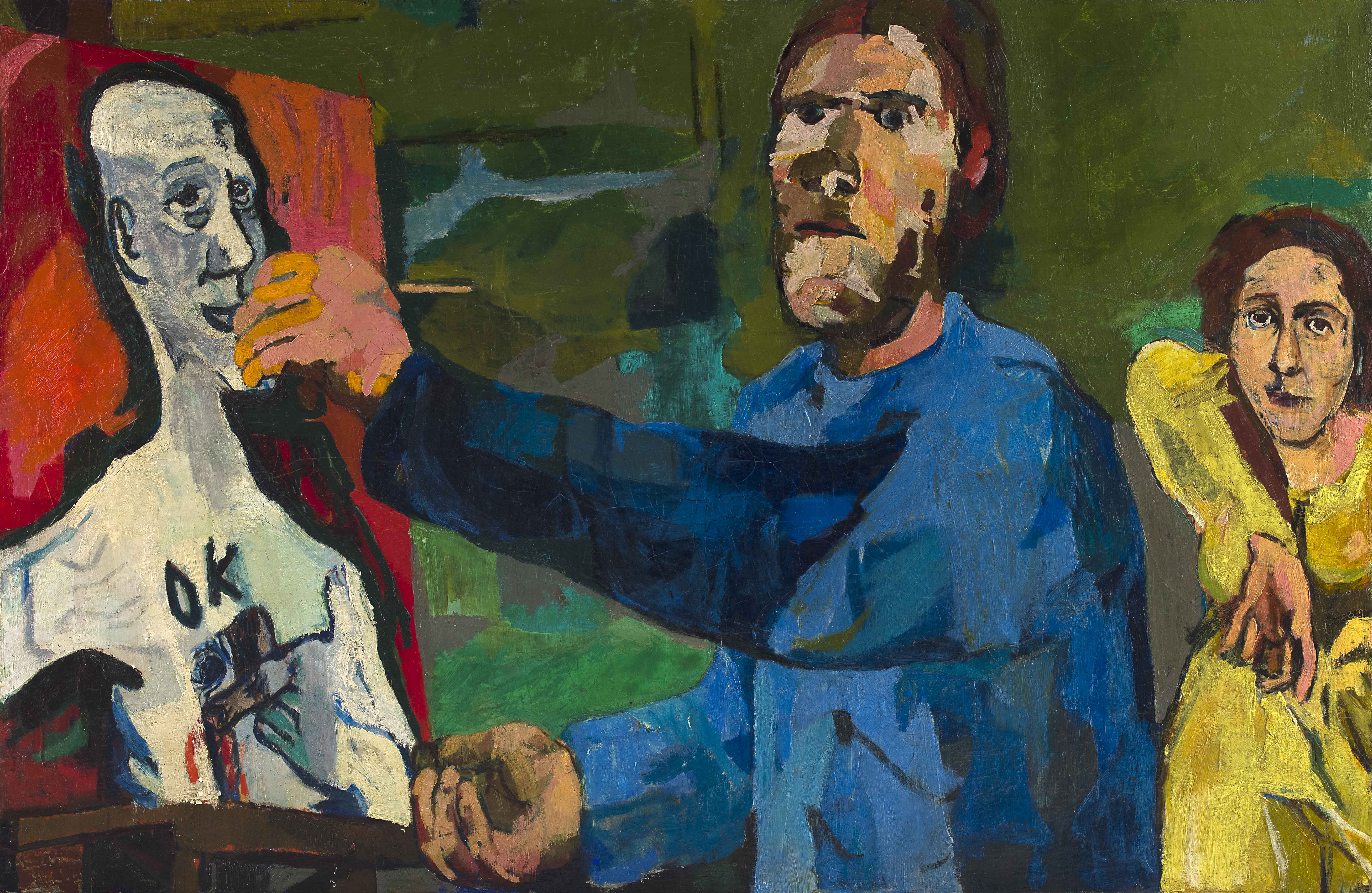
Huile sur toile, 85.5 × 130.5 cm
Saint-Louis, Saint LouisArt Museum, Bequest
Morton D. May,
© Fondation Oskar Kokoschka, 2023, VEGAP, Madrid
Rajesh Punj: Regarding Oscar Kokoschka, you were asked a question before about his initials as they appear on many of his paintings, ‘OK’, and it leads one to consider its double meaning, of one being ‘OK’, which brings you back to the painter, to his monograph, and to his not being ‘OK’ – of his being ‘OK’, but never being okay his entire life, for all of the reasons that you point to in his works. He appears to have been troubled, and you refer to some of that anxiety for his using his nails to register something of his pain on the canvas, tormented, as he was his entire life.
Dieter Buchhart: I would say it came in phases. To start, Kokoschka was very energetic in the beginning. He wanted to conquer the world and he was going against so much of what had been done before. That was when he used his fingernails and scratched in the colours. I mean, he was never fully accepted by art history, and then the First World War came, and it proved the greatest trauma that occurred for him. His contemporary, the German painter Otto Dix believed in the war in the beginning, and for all of the initial euphoria, many men died there, and those who came back were all greatly affected by it. Kokoschka thought a lot like (Otto) Dix initially and then changed his mind about the war. He knew he couldn’t avoid going to war, but he was never prepared for it. There was a moment when Kokoschka was nearly killed by a bayonet, and almost shot in the head, and then later on, there was an explosion on a bridge, that nearly killed him the second time; the accumulation of which was of his being unfit for war, which proved his salvation.
But, of course, the cruelty of war shaped him, and you see that in the 1917 portrait Selbstbildnis, with the emptiness of his eyes, it proves a very tragic self-portrait, but it’s a work that mirrors the time beautifully. The choice of colours is incredible, the shade of blue he uses in that work is unbelievable. It feels like you can easily fall into the denseness of the colour, for the way he paints it. And then from the trenches to the top of the hill, he looks at the city as a landscape. He wanted to see everything from above, and not in the dirt, and he established himself as an artist very quickly after that. Developing this colour expression until it narrowed him down too much. Teaching at the same time, more for the title than the obligation, with the academy telling him at a certain moment, ‘You are never here so there is no reason to have you as professor’, and with that, he was happy to leave. Kokoschka was living in Dresden at the time and started to travel. I mean he was traveling all the time until he came to Paris. He goes to Morocco, traveling from one city to the next, and it was very freeing for him. You can tell I mean; he changed his style from creating isolated planes of colour to someone who renewed paints.
RP: Is that what’s happening, during that period was he still painting himself, or was the landscape and location everything for him then?
DB: No, his works at that time included portraits, which was not lost on him at all. It’s interesting to consider that when he undertook to travel, he still managed sixty portraits, of a total of three hundred and eighty paintings. In the beginning, he was very prolific, but with his leaving Dresden in 1923, decided to paint himself less, choosing different genres, including landscape and allegorical works; so, it changed. And while he was traveling, he was in London, but he couldn’t have been there for many weeks because it’s less documented; Kokoschka was in certain places in England, but you don’t know when he was there.
RP: When I think of Kokoschka, it has me go back to university, my knowledge being limited in comparison. What intrigued me, when thinking exclusively about the artist, is where he sits historically. Seeing so many of his works for the first time, I think something of the Expressionists, George Grosz, Max Beckmann, and Ernst Ludwig Kirchner, for their contorted and sometimes intrusive figures, particularly with the work that you pointed out in your representation, The Artist and the Model 1923, in which a woman is seen sitting to the right of the painter. So, I am very interested to understand his significance. Kokoschka’s influence is huge.
DB: Certainly, what we didn’t speak about before was for example how Kokoschka inspired Hans Bellmer when he was living in Paris. It is interesting to understand the influence of Kokoschka, which was crucial to Hans Bellmer’s photography. Likewise, Kokoschka was taking photographs, but was still unsettled in Paris, never feeling welcome enough there. Paris was not easy for artists from Central Europe and Scandinavia; many of them never managed to make it there. I mean, now it’s a little different. But still, when you think of Anselm Kiefer, who lives in the south of France; he has his property there, he is more like this German international artist, and he’s not connected to the French establishment. So, in that sense, it’s interesting, because Kokoschka thought about settling in Paris, went back to Vienna, left Vienna for Prague, and then had to leave for Britain, which was less of a choice that was a more necessity. And then, of course, he had to leave.
RP: I imagined him as an outsider, as an independent.
DB: He was very independent; he was an artist who was never really part of any movement.
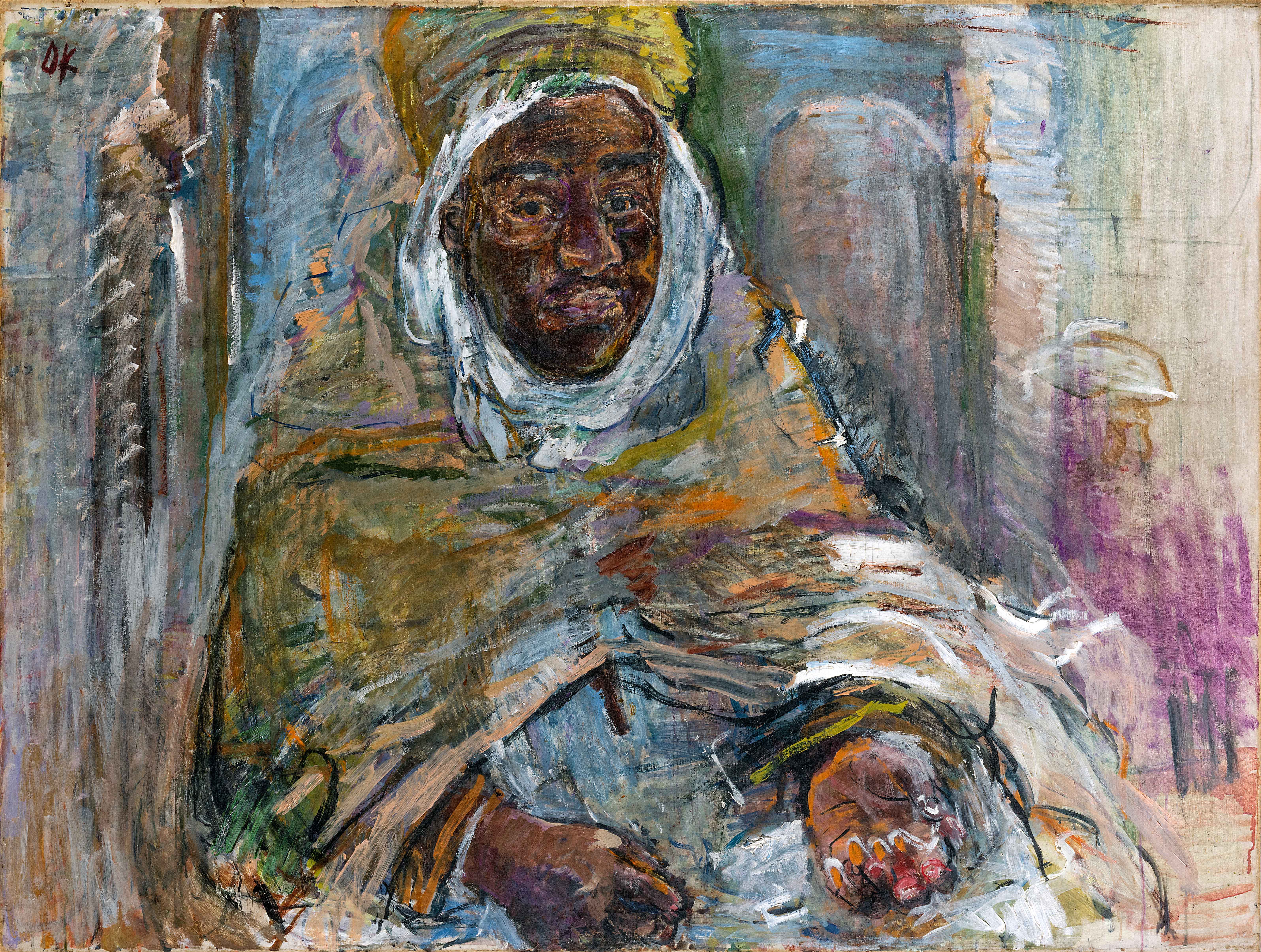
Tidjani) / Le Marabout deTémacine (Sidi Ahmet Ben Tidjani)
[Der Marabout von Temacin (Sidi Ahmet Ben Tidjani)], 1928
Oil on canvas, 98.5 x 130.5 cm
MuséeJenisch Vevey – Fondation Oskar Kokoschka,
© Fondation Oskar Kokoschka, 2023, VEGAP, Madrid
RP: Was he talking to other artists, in terms of other manifestos and movements?
DB: Oh, all the time, but he does it his way. He’s never compromised, choosing not to go into abstraction. On the other hand, when you look at the backgrounds, some of his paintings are abstract. Beautiful works when you look at some of the early ones, from 1909 and 1910. So, it’s all there, in 1911, 1912, his time with Alma Mahler, when he was painting these crystalline tones when he was obviously in love with her, and which, of course, reflects his interests that were not to do with Cubism, still seeing everything in ‘three-hundred and sixty degrees’. His transparent works are interesting because there was a reason for his choice of colours. With his not being connected to the Parisian art scene, because of who was there in the 1920’s. At the time his contemporaries were all coming from Abstraction and moving towards Surrealism, which introduced a different dimension. None of them come from figuration, as was Kokoschka’s way.
RP: What interests me, and something we talked about in Zurich with Picasso and Giacometti, is that Picasso was incredibly assured of his touch, and it seems that with Kokoschka there is a nervousness to his actions.
DB: With his uncertainty, it’s interesting, because it is something that as a child, I was very receptive to. I always saw it as something like nervousness. (Jean-Michel) Basquiat had something of that same energy. Today I see it differently, of the layers Kokoschka applied, one over another, and it looks incredible for his introducing so many colours, and as many brushstrokes, that are moving in many directions. But in the end, it involved very solid layering and conserving during his lifetime, and this artistic process is similar to Giacometti’s.
For me, Kokoschka approached everything very differently from Picasso, even though it wasn’t entirely different because he would say ‘My work is never finished’, grabbing the next canvas for ‘painting time’, which is a beautiful term. With Kokoschka, it’s the search for the absolute that has him close to Giacometti. In the end, Kokoschka finished everything in England. From the beginning of the 1920s, it proved incredible, he stuck to one work until it was complete, reworking paintings all the time, but fundamentally thinking about just one work. Kokoschka still works on many paintings at the same time, but in the end, I think of him as an artist who would have been happy with the process of finding the absolute painting, which was Giacometti’s intention, but never actually finding the ‘total’ work.
RP: But it’s when you come back to a work, of there being no sense of completion, a kind of torment.
DB: It really was that, of there being no sense of completion. I mean, a source for so many of his works was ‘the doll’ that Kokoschka had made by Hermine Moos, and then many of the people’s portraits look like him a little bit. So, it’s hard, as Anna pointed out, to know who the woman in the painting was, was it an older woman, or the girlfriend he had before? He must have started with Olda Palkovská at the very beginning, and then the work became someone else. Don’t forget the expensive large canvas and paint. In England he made several wall paintings, ‘anti-works’ would be the right term, and then he had these small canvases to paint on, that became so intense.
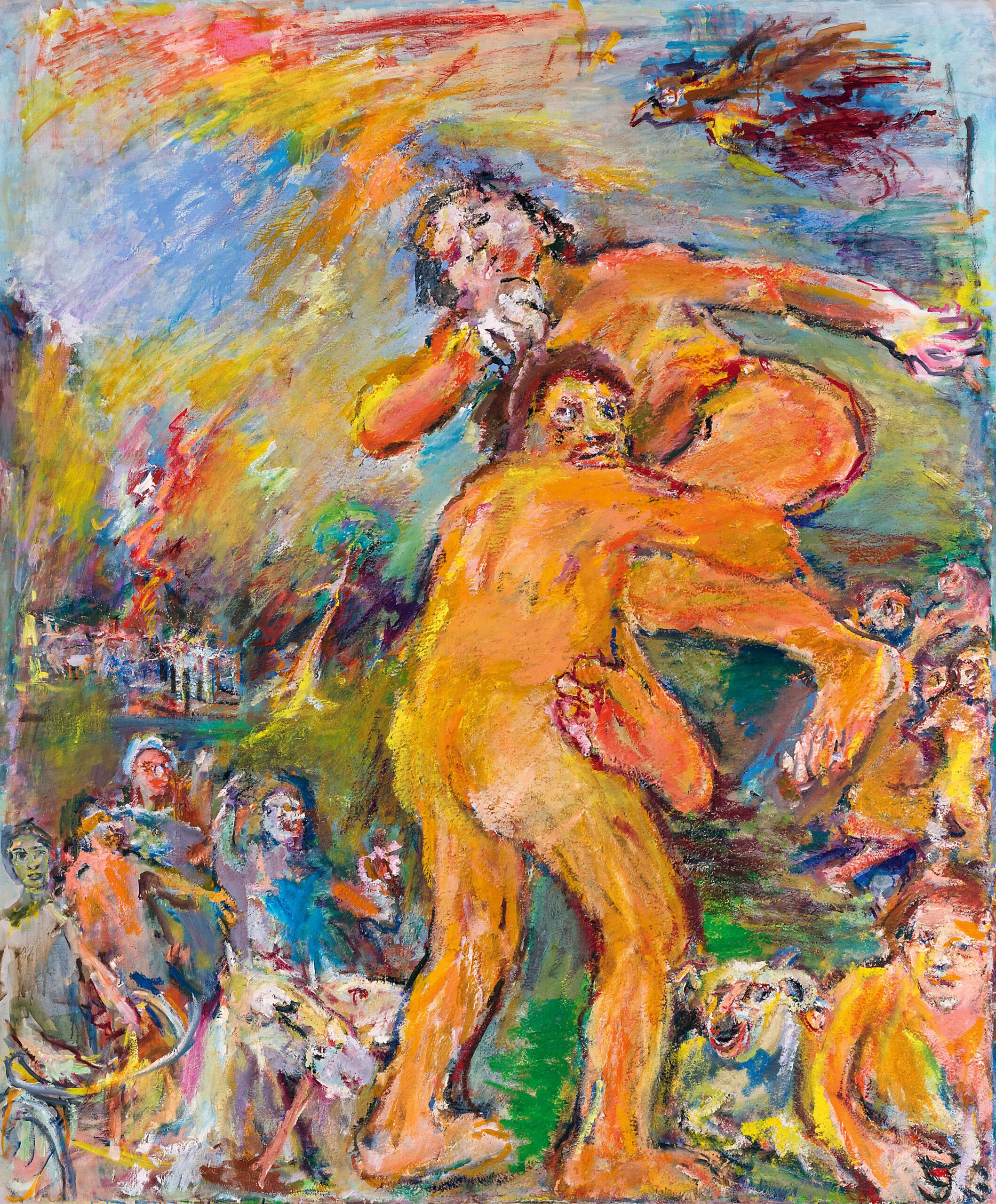
Thésée et Antiope, [Theseus und Antiope],
1958-1975, Oil on canvas, 195 x 165 cm,
MuséeJenisch Vevey – Fondation Oskar Kokoschka,
© Fondation Oskar Kokoschka, 2023, VEGAP, Madrid
RP: I’m just discussing Kokoschka with Dieter and it would be lovely to have you join us, Anna. I was asking Dieter about Kokoschka’s touch as a painter, because, and as context, Dieter and I met before in Zurich, where we talked at length about Pablo Picasso and Alberto Giacometti, and I suggested already it might be a kind of nervosity.
Anna Karina-Hofbauer: A nervous touch of a kind, yes. I would say and this is what is so fascinating about Kokoschka, that it’s a constant renewal. His is a search for I would say, a truth in painting. So not only in the beginning searching for the soul of the sitter, but then it turns into a physical phenomenon, of his painting style changing. So, you have many parallels working together.
RP: In almost all the portraits no one appears to be sitting comfortably, and you talked about how he asks them to be natural and even to move around. With that, there’s a kind of awkwardness to them, as though it gave him permission to be himself – leaving and returning to the room, reaching for different brushes, and colours.
DB: In the end, it never stopped for him, with this preoccupation for capturing something that you weren’t able to contain. Photography came close to what Kokoschka was doing, with the long exposure shots. But unlike a photograph, Kokoschka managed to introduce so many possibilities and impressions to one work, and that’s incredible. I don’t know an artist who worked in the same way.
AKH: There is a sense of frustration in his work.
DB: Kokoschka wanted to do what he wanted. i.e., capture the soul.
AKH: For Kokoschka, it was about the immediacy of the moment, whether he was able to concentrate on that or not. But he continues searching during this period for the truth, maybe not for absolutism in the way Giacometti was, but more for a version of the truth, and this is also why his style is constantly developing because he is trying to reinvent himself at the same time.
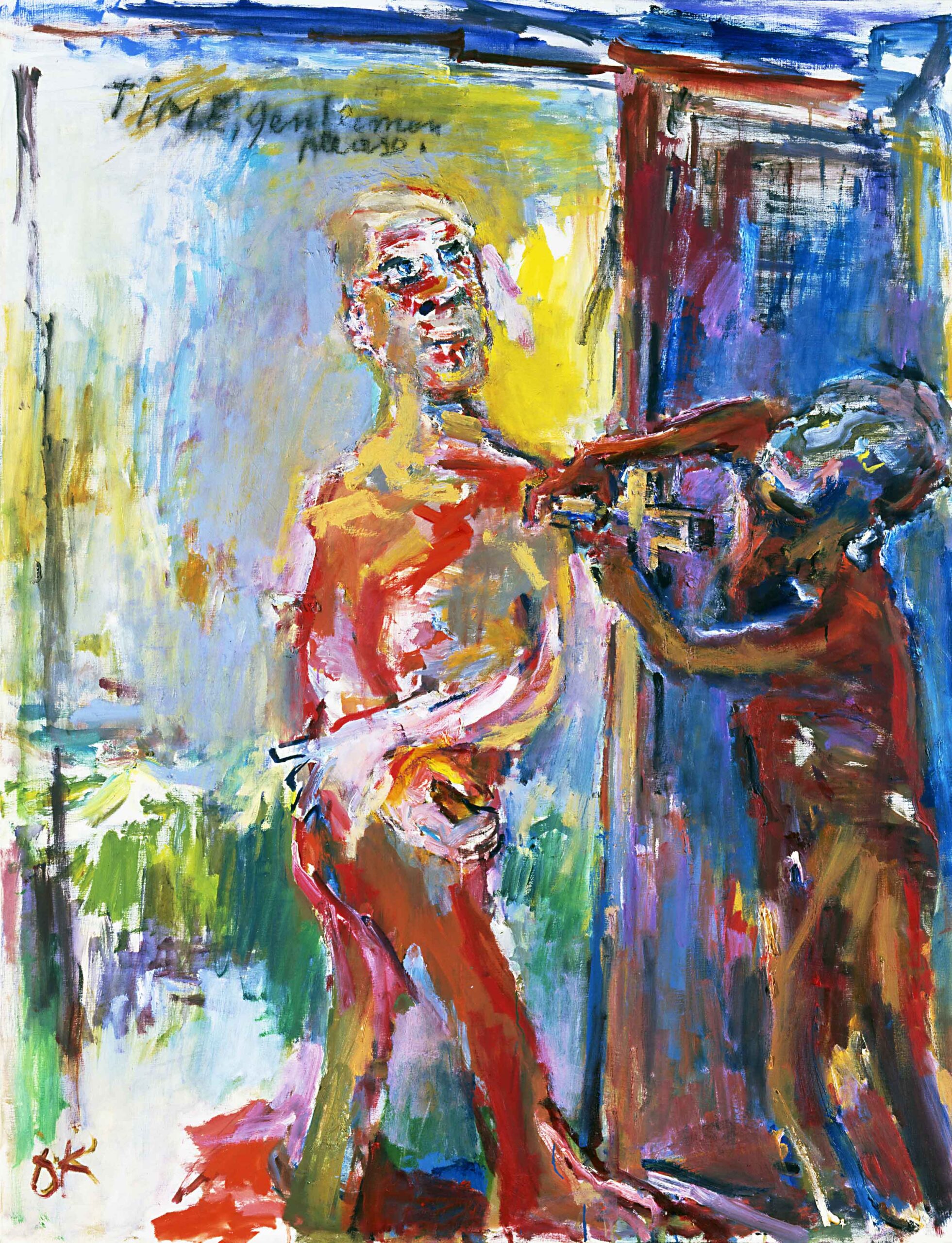
Oil on canvas, 130 x 100 cm, Tate, acquis en 1986,
© Fondation Oskar Kokoschka, 2023, VEGAP, Madrid
RP: And do you think he finds that? As a question, does he achieve closure and find contentment in that work? Maybe that’s not the right way of looking at it, because it suggests ‘completion’.
DB: When we look at Time, Gentlemen Please, 1971-72, for me, this work is certainly about a dissolution of time, and possibly the truth that can be found in the painting for the illusion of the human being.
RP: It literally looks like he’s coming apart.
AKH: I think so, from a wholeness.
DB: Because it’s based on a trauma.
AKH: It is because I think that during the decades after the (First World) war, he’s constantly working, and it’s like he undergoes psychotherapy every time he encounters himself. You see that in whatever way he paints himself.
DB: He’s thinking a lot you imagine.
RP: It appears so; there is a definite restlessness about him, and it appears as though the paint in ‘time, gentleman please’, witnesses his coming apart.
DB: Yes, exactly. I completely agree.
RP: In that sense, is there a weight to the paints? A sense of rupture, it’s really strange.
DB: Dissolution is a pretty good argument because it is his search for the truth. Entropy, that we cannot escape the fate of being, and that in the end is what is happening in his works. Layer after layer, coding and conserving a lifetime.
RP: I wonder about his relationship with people, that fascinates me.
DB: I think he must have been able to connect with people. Let’s put it that way.
AKH: You have to see him because he’s very self-confident, and he’s very much aware of his surroundings and the people he’s engaging with.
RP: But I find it interesting when we walked through the exhibition, you talked about how on many occasions Kokoschka looked into the face of the sitter rather than at them. I find that interesting, because I see it as unsettling for them, to be that intensely understood, and for everything of the facade, that for Kokoschka that they all become transparent. As if they exist, by name, profession, in society, and at the same time they are entirely anonymous, lifeless. That fascinates me.
DB: I never thought of it that way.
RP: Of the ego, and their identity, being removed.
AKH: I’m sure not everybody was happy with the way that he portrayed them. Think of Viennese society in 1910, they were more used to these more beautiful portraits of Gustav Klimt, portraying his sitters in a completely different way, and then you have Kokoschka looking into them. It was a completely alien approach.
RP: And in that sense what interests me is this notion of beauty, because Kokoschka offered a completely different version. As if the mirror has cracked.
AKH: Yes.
DB: It’s more radical, rawer.
Read More>> Please Subscribe our Physical Magazine
